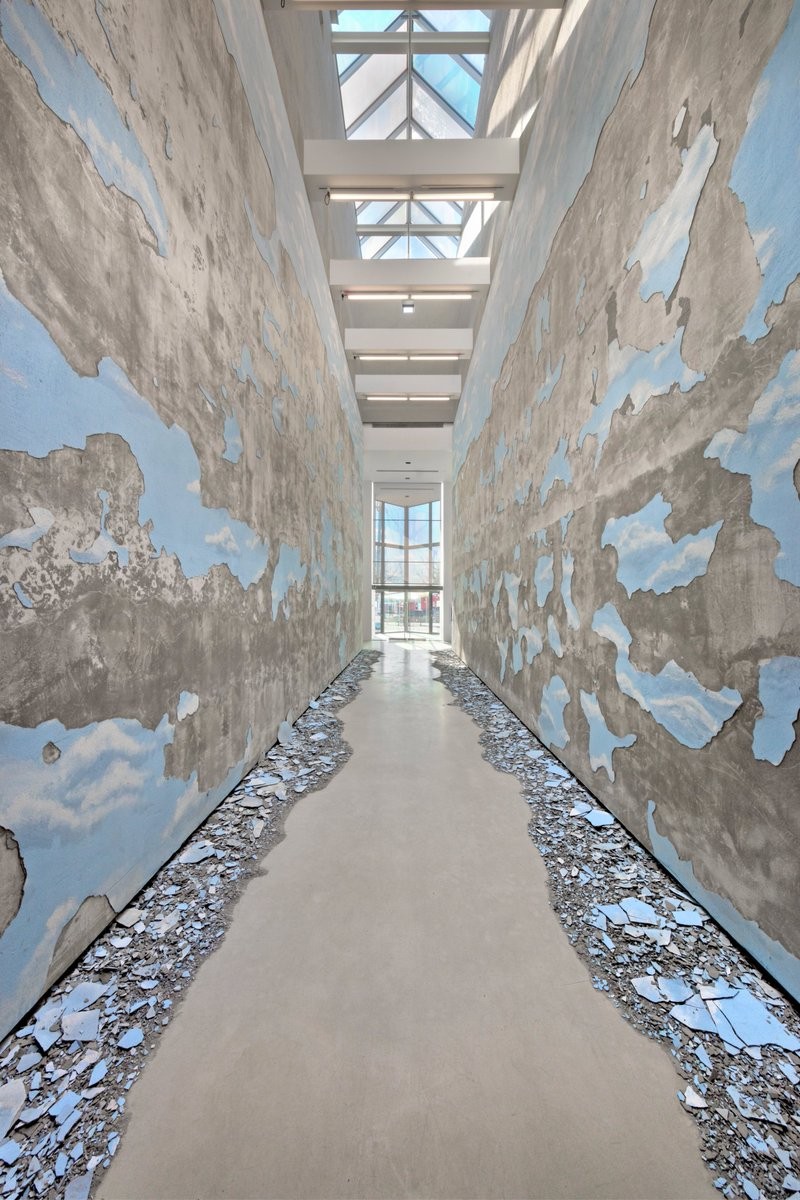Latifa Echakhch
15 Oct 2016 - 15 Mar 2017

Latifa Echakhch: Cross Fade
Installation view: The Power Plant, Toronto, 2016
Photo: Toni Hafkenscheid
Installation view: The Power Plant, Toronto, 2016
Photo: Toni Hafkenscheid
LATIFA ECHAKHCH
Cross Fade
15 October 2016 - 15 May 2017
Curator: Carolin Köchling
Developed for the second iteration of the Fleck Clerestory Commission Program in a space characterized by its openness in all directions – to the sky, the waterfront and the surrounding galleries – Latifa Echakhch’s Cross Fade confronts viewers with a sky that is literally falling.
In Echakhch’s process-based works, audiences are presented with the traces of an action. For instance, in Stoning (2010), the artist took bricks from a crumbling building – now a heritage site – and chiseled them into stones, recalling the type used for this method of punishment or execution. The tragedy that has befallen this place appears to have passed and all that remains are the fragments of cast stones. Such gestures of abandonment and absence feature regularly throughout Echakhch’s oeuvre.
Like Stoning, Cross Fade evokes the remains of an action that has already taken place. Echakhch’s wall painting of the sky appears to be falling apart. Fragments of the sky still exist intact on the upper sections of the walls, out of reach, reminding us of its beauty. However, large parts of the sky lie on the ground, creating a peculiar feeling that something beyond our control is either happening or has just happened. The technique employed here references the classical fresco, a second skin that usually leads the viewer into a painted world, a trompe-l'œil, rendering the two-dimensionality of the wall invisible. On the contrary, Echakhch’s work shatters this illusion, rooting us in the present, which like a cross fade, is caught between the past and the future.
The sky has previously appeared in Echakhch’s work La dépossession, where it is printed across a collapsing theatre canvas and suspended from the ceiling. In this earlier work, the sky is used as a motif to deconstruct the spectacle and intrigue of the theatre. In Cross Fade, Echakhch gives the sky material form. Rendered in cement and applied to the gallery walls, it is no longer just a motif but also an object, capable of being destroyed. Here, an element we usually associate with permanence loses its stability, taking on a state of a ruin that underscores the uncertainty of the present and speaks to the loss of a common space.
Having exhibited extensively in museums and exhibitions worldwide, this is the first presentation of Echakhch’s work in Canada.
Cross Fade
15 October 2016 - 15 May 2017
Curator: Carolin Köchling
Developed for the second iteration of the Fleck Clerestory Commission Program in a space characterized by its openness in all directions – to the sky, the waterfront and the surrounding galleries – Latifa Echakhch’s Cross Fade confronts viewers with a sky that is literally falling.
In Echakhch’s process-based works, audiences are presented with the traces of an action. For instance, in Stoning (2010), the artist took bricks from a crumbling building – now a heritage site – and chiseled them into stones, recalling the type used for this method of punishment or execution. The tragedy that has befallen this place appears to have passed and all that remains are the fragments of cast stones. Such gestures of abandonment and absence feature regularly throughout Echakhch’s oeuvre.
Like Stoning, Cross Fade evokes the remains of an action that has already taken place. Echakhch’s wall painting of the sky appears to be falling apart. Fragments of the sky still exist intact on the upper sections of the walls, out of reach, reminding us of its beauty. However, large parts of the sky lie on the ground, creating a peculiar feeling that something beyond our control is either happening or has just happened. The technique employed here references the classical fresco, a second skin that usually leads the viewer into a painted world, a trompe-l'œil, rendering the two-dimensionality of the wall invisible. On the contrary, Echakhch’s work shatters this illusion, rooting us in the present, which like a cross fade, is caught between the past and the future.
The sky has previously appeared in Echakhch’s work La dépossession, where it is printed across a collapsing theatre canvas and suspended from the ceiling. In this earlier work, the sky is used as a motif to deconstruct the spectacle and intrigue of the theatre. In Cross Fade, Echakhch gives the sky material form. Rendered in cement and applied to the gallery walls, it is no longer just a motif but also an object, capable of being destroyed. Here, an element we usually associate with permanence loses its stability, taking on a state of a ruin that underscores the uncertainty of the present and speaks to the loss of a common space.
Having exhibited extensively in museums and exhibitions worldwide, this is the first presentation of Echakhch’s work in Canada.
